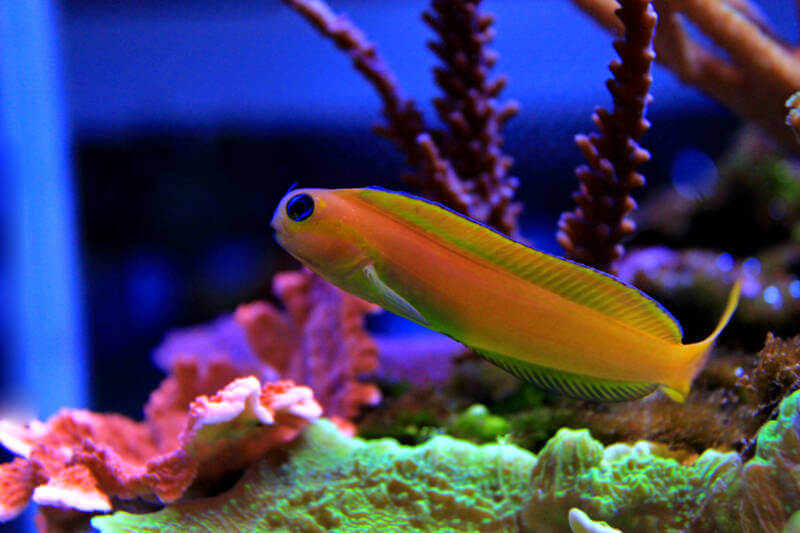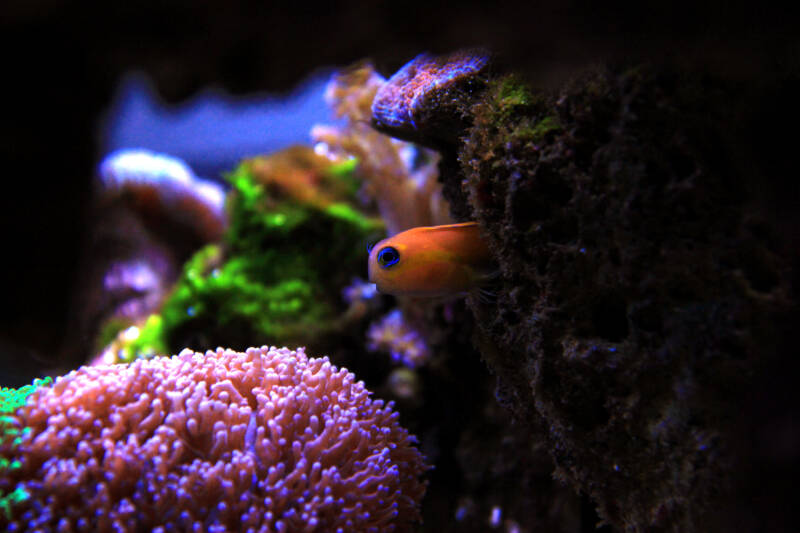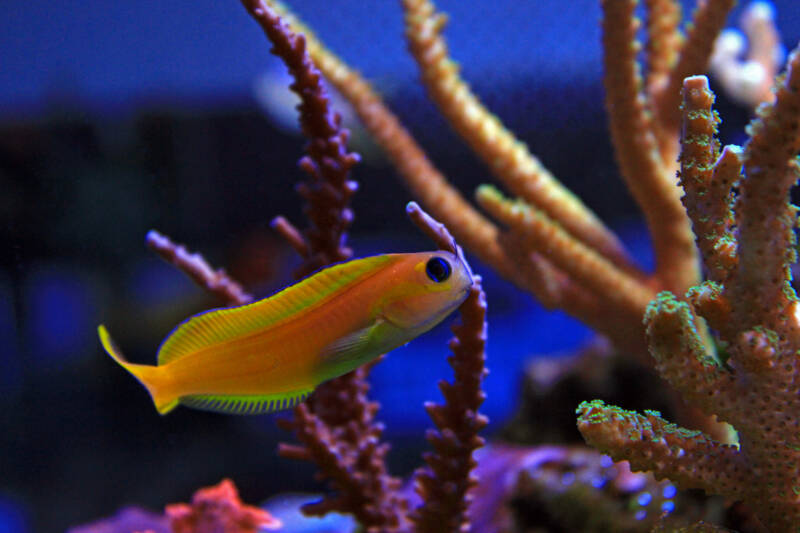Form and function don’t always come along when you start looking for top fish for your reef tank. Then you stumble across the Midas blenny (Ecsenius midas).
A gorgeous fish that’s entertaining to watch stands out against the décor AND provides a handy chore? Too perfect.
That golden yellow color is the first thing that catches the eye for this member of the Bleniidae family.

And it’s why you also see them referred to as yellow blennies, golden blennies, or lyretail blennies. (Okay, so the last one isn’t color-related – it refers to their shape)
“Midas” comes from the Greek myth of King Midas. The ruler’s granted a wish (or is it cursed?) by Dionysus, the god of wine and revelry, to have everything he touches turn to gold.
The vibrant yellow of their bodies prompted scientists to link the blennies to the infamous king.
However, anyone familiar with the myth knows it came with a harsh lesson.
And you’ll need to keep some things in mind before you bring a Midas blenny home to your marine tank. (Don’t worry, there’s no risk in touching them)
Making sure you know everything first is a good start.
At a Glance
- Tank Size: 20-30 gallons (76-114 l)
- School Size: One is safest
- Lifespan: 2-5 years
- Size: 4-6 inches (10-15 cm)
- Temperature: 73-84°F (23-28°C)
- pH: 8.1-8.4
- Hardness: 8-12 dH
- Specific Gravity: 1.020-1.025
- Ammonia: 0 ppm
- Nitrite: 0 ppm
- Nitrate: 0 ppm
[toc]
In the Wild
Midas blennies show up on coral reefs throughout the Indo-Pacific.
They’re a popular sight around the Maldives and up the southeastern coast of Africa. The most popular spots are rocky outcrops and corals with abundant caves, crevices, and water currents.
It’s common to spot that burst of golden yellow color in the middle of other shoals of fish.
As planktivores, Midas blennies know to go where the food is – and they’ll join in the fray with pink bar anthias, fusilier damselfish, or sea goldies.
The schools provide another valuable benefit for these blennies – a boost of buoyancy.
They lack swim bladders and can’t remain in the water column for significant periods. The additional fins working around them give them the lift they need to snap up tasty snacks drifting by.
And since that bright flash of yellow may or may not stand out?
The Midas blenny has a handy trick of changing color. They can blend in with the crowd or even the rocks they’re exploring.
The color-change can also represent a shift in the blenny’s mood (or health).
Size: Nano-Approved?
Aquarists love the Midas blenny for their color, behavior, and dietary habits. But they’re also handy to have around because they don’t require a ton of room.
They only top out around 4-6 inches (10-15 cm) when they finish growing.
Lifespan
Even with their ability to adjust coloration, Midas blennies find themselves on plenty of other fishes’ menus.
They have a few tricky management needs that aquarists can struggle with, too. So it’s no surprise to find they only manage an average lifespan.
You only see this cheerful-looking blenny surviving around 2-5 years. And that’s with excellent care and dietary needs.
It isn’t the most impressive lifespan among saltwater fish species. And if you slip up on water quality? It’ll REALLY drop.
Behavior
Without a swim bladder, the Midas blenny adopts a curious swimming pattern – when it decides to venture into the open in the first place.
You’ll see the rear half of the fish “droop.” Meanwhile, it’ll ribbon through the water, a little like an eel.
Most of the time, though? This bright yellow blenny prefers to “hop” and climb around on the coral and rocks.
It’s a behavior that can get them confused with wrasses and gobies. But it’s ideal for allowing them to graze and forage for their favorite foods.
It also provides a quick escape when they feel nervous. You’ll often find a blenny face peeking out of a cave.

Or you could catch a glimpse of your Midas blenny swimming BACKWARD into that same cave. Both are common behaviors.
And while this species enjoys swimming with other schools, you won’t find them forming shoals of their own.
Midas blennies DON’T get along with each other. They’re territorial and WILL chase another blenny out of the area. As such, they’re better kept one to a tank.
They won’t get lonely on their own. Instead, you’ll get a chance to see that color change as they pair up with your other tank fish.
Just keep an eye on the available space in your aquarium. In tight quarters? They have a mean streak that can come to the surface.
Tank Setup
Due to their size, it IS possible to keep a single Midas blenny in a nano aquarium.
Ideally, though, you don’t want to go any smaller than 30 gallons (114 l).
You want to ensure you have enough room to set up the rocks they need.
If you plan to keep more than one blenny, you need to increase your tank size – by a factor of three.
A minimum of 90 gallons (340 l) is required to ensure they’ll each have the territory room they’ll carve out – without causing unwanted fights.
You DO need a tight-fitting cover without any gaps. Midas blennies can jump and escape to carpet surf.
They frighten easily (especially when they’re near the top of the tank), and due to their small size, it’s easy for them to find openings in screens.
And remember that lack of a swim bladder? You need to consider the water current you have in your aquarium.
Try to keep your flow between medium to strong. This mimics the current they enjoy on those rocky outcrops in the wild, buoying them up when they take to the water column.
Water Conditions
If you’ve set up your saltwater aquarium with standard water parameters, your Midas blenny should do well.
They don’t need special water conditions outside of what you’d expect: a temperature between 73-84°F (23-28°C), a stable pH of 8.1-8.4, and hardness of 8-12 dH.
When it comes to water quality, though, you need to remain on top of your game.
These blennies lack scales. And if you allow your ammonia, nitrates, or nitrites to build up, they’ll easily succumb to illness.
You’ll know because they’ll start to change color – and not in a good way!
Decorating the Midas Tank
A Midas blenny’s favorite activity is exploring rock work in search of their next meal.
You already know they’re not big on swimming. So you want to concentrate your décor on providing the best structures for climbing.
Live rock is your best source for caves, ledges, and crevices. Not to mention it’ll provide a handy “reservoir” of food for your blennies.
The natural structures will provide places to perch and climb while also giving them spots to retreat to for sleeping and hiding.
You can also add live sand to boost the possible nutrients for your blenny.
These fish use their comb teeth to “sift” microfauna out of the particles. You won’t see them bury themselves in the sand as you will other species, but live sand won’t hurt to have around.
And since the Midas blenny uses caves for sleeping – rather than diving into sand – you don’t need to worry about a deep sand bed.
A standard level will do nicely. Just ensure you have a sump tank to keep up with the potential extra waste.
Midas Blennies in Communities

As you might guess from their behavior in the wild, Midas blennies do well in community aquariums.
They’re well-behaved little fish – under the right circumstances. You want to keep some things in mind when mixing these shy yellow fish in certain situations.
Tank Mates
If you have LPS or SPS corals or anemones in your tank, you don’t need to worry.
The Midas blenny is reef-safe. They’re not interested in polyps or harassing most invertebrates.
And their size prompts them to leave your cleaner shrimp alone.
They get along well with plenty of saltwater species. That is, as long as you make sure there’s room for everyone in the tank.
Aggression becomes an issue when the blenny feels crowded. Even when you’re talking about these unrelated tank mates:
- Angelfish
- Anthias
- Boxfish
- Butterflyfish
- Cardinalfish
- Clownfish
- Damselfish
- Filefish
- Goatfish
- Grunts
- Hawkfish
- Puffers
- Squirrelfish
- Tangs.
Incompatible Species
Unfortunately, a “peaceful” temperament isn’t always a guarantee your blenny will do well.
That yellow color can signal “fiery temper” when this fish encounters certain groups. And it starts with other blennies.
The Midas blenny won’t tolerate ANY blennies in the same tank.
You’ll also need to avoid other planktivores. It isn’t that your blenny will pick fights; it’s usually an issue with resources.
Aquarists struggle to provide enough food for everyone, and territory disputes erupt. So skip adding firefish and gobies to your tank.
Food and Diet
https://www.youtube.com/watch?v=XqBjGbkpT9Y
As they officially prefer plankton, the Midas blenny falls squarely in the omnivore category.
It makes them easy to feed – provided you can keep up with their active demands.
They scavenge through the tank all day and need food at least three times a day.
But menu choices? Those are easy. They lean heavily on the plant side of things, especially the algae they find around the tank.
Of course, you can’t expect your blenny to survive on algae alone (especially if you have a clean tank). So you’ll want to supplement them:
- Formula Two
- Seaweed
- Spirulina-based commercial foods.
Don’t forget the meat side of the equation, though. You want to chop up suitably small pieces of quality proteins to ensure that the golden yellow color remains vibrant.
You can use frozen, freeze-dried, or live versions of these favorites:
- Brine shrimp
- Clams
- Cyclop-Eeze
- Krill
- Mussels
- Mysis shrimp.
Unlike similar species (such as certain wrasses), the Midas blenny is NOT a cleaner fish.
They’ll happily chow down on copepods your refugium supplies, but you can’t expect them to “groom” other fish.
If you see them nipping at a tank mate – it’s aggression, NOT cleaning.
Breeding Midas Blennies: Not Just Yet
So, unfortunately, no one’s managed to breed Midas blennies in captivity yet successfully.
Other blennies in the Ecsenius genus HAVE settled into aquaculture breeding situations, but this species is slightly different in its habits, making things challenging.
Blennies are nest guarders. But the Midas blenny adds the twist that a single male watches over a nest for multiple females. (They’re harem spawners)
The eggs get fertilized on different nights, resulting in multiple hatching times.
And trying to duplicate this in captivity hasn’t worked.
To start, you need to supply a tank large enough for a harem to exist peacefully.
Then you need to collect all of the eggs as they appear in the nest.
And providing the rotifers, copepods, and food cultures for the fry – at each growth stage? The complication is too much.
Male or Female?
As if balancing all of that wasn’t enough, trying to sort your male and females isn’t easy, either. The two look almost identical.
If you can match two together, you WILL see that female blennies come out a touch smaller. But it’s a subtle difference.
Midas Blenny Health
Without scales to provide the first line of defense, the Midas blenny is susceptible to parasites and disease.
And they’re sensitive to any changes in their environment. You’ll see the resulting stress expressed by changes in color.
Acclimation is crucial for this species of blenny.
They’re a wild-caught saltwater species, and you’re always going to have differences between their natural habitat and your reef tank.
Ensure you take time with introductions – even when moving from the quarantine to the display tank.
Midas Blennies: Are They For You?
Due to the lack of a captive breeding situation, you’ll see Midas blennies run from anywhere between $30-$50.
The larger the fish, the higher you can expect the cost to run.
Don’t rush to purchase a larger fish without verifying its health, though. Bigger isn’t always better.
Because transport often leads to stress, make sure you get a chance to see your chosen blenny eat at the fish store before you confirm your purchase.
You want vibrant colors on an active fish that eagerly accepts food. An unhappy, sluggish blenny may not last very long.
Striking Gold in Your Saltwater Aquarium
Aquarists fall in love with the golden yellow shade of the Midas blenny.
And the fact they’ll graze on algae around the tank?
That’s a bonus. So’s the chance to watch them ribbon back into a cave. Form, function, and entertainment? It’s a total jackpot!
Do you have a Midas blenny? What color changes have you witnessed?
Do you see them joining in with any of your other shoals?
Let us know your stories and questions here!
